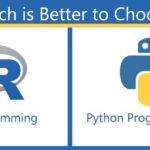The selection of the right tool can be the difference between success and failure in a data science project. Do you want to go with Python, which has a strong set of libraries and a lot of potential for deep learning, or take advantage of R, which is superior for statistics, analysis, and visualization?
With the data science field moving quickly, it’s important to be aware of the strengths and weaknesses of each programming language. In the blog, we will analyze each option to help you determine which tool will best fit your project, whether that project includes complex models, data analysis, or insights for decision-making.
Python for Data Science: Versatility and Integration
Python’s versatility and ease of use have established it as a heavyweight in the world of data science. Due to its readable syntax, it is approachable for beginners, and its extensive library ecosystem allows for an array of data science deliverables. Python’s use rose 7 percent in 2025, making it the most popular language for developers (Stack Overflow, 2025).
Advantages:
- Numerous Libraries: Python has a vast collection of libraries, including Scikit-learn for machine learning, Matplotlib and Seaborn for visualization, NumPy for numerical calculations, and Pandas for data management.
- Deep Learning Frameworks: Python has emerged as the preferred language for deep learning projects due to the availability of libraries such as TensorFlow and PyTorch, which make it possible to create intricate neural networks.
- Integration Capabilities: Python is a flexible option for end-to-end data science workflows due to its interoperability with several platforms and its capacity to interact with databases, web applications, and automation tools.
- Community Support: A large and vibrant community guarantees ongoing advancement, an abundance of resources, and broad industry adoption.
Ideal Use Cases
- Machine Learning & Deep Learning: Python’s libraries and frameworks seem to be built for crafting and deploying machine-learning models.
- Data Engineering: The integration features support building and automating data pipelines.
- Web Development: The frameworks Flask and Django enable building web applications with data-driven functionality.
R for Data Science: Statistical Analysis and Visualization
R was developed solely for statistical analysis and has been a go-to language/software combination in academia and research for decades. It’s a collection of specialized packages and functions that are organized and geared to computing statistics and producing high-quality visualizations.
Strengths:
Statistical Packages: R has a myriad of packages, for example, ggplot2 for data visualization, dplyr for data management, caret for machine learning, and other packages designed simply for statistical analysis or model assumptions.
Publication-Quality Graphics: The ggplot2 package gives the user the ability to create complex, multi-layered visualizations for publication.
Statistical Analysis: It has every statistical test and model used in statistical analysis; data analysis cannot be conducted without a part of R.
Learning: R is used in academia a lot. When students take advanced or PhD-level statistics, they are immersed in different statistical methods and research-related resources.
Ideal Use Cases
- Research Activities: R’s statistical functionalities serve well for projects requiring extensive analyses of data.
- Data Visualization: Applicable for projects where the requirement is for precise, high quality visual output of the data.
- Statistical Modeling: Applicable to projects focusing on explicitly applying statistical models to datasets.
Actionable Tips for Choosing Between Python and R
When choosing between R and Python for your data science project, concentrate on doable tasks that fit your objectives and methodology.
Establish Your Project’s Goals
Start by defining the precise duties and results you hope to achieve. R’s targeted packages may be useful for projects involving intricate simulations, specialized statistical tests, or exploratory analysis, while Python is best suited for managing big datasets, automating workflows, and implementing machine learning models.
Assess Learning Style and Resources
Think about the way you learn best. For hands-on, project-based learning, Python provides a large community, interactive coding platforms, and comprehensive tutorials. R’s resources frequently focus on scholarly examples and applications with a research focus. You can make faster progress by selecting a language that suits your learning style.
Check for Specialized Tools
Find out which language has libraries or packages designed specifically for your project. While Python frequently offers the updated deep learning frameworks and integration choices, R may already have statistical tools available for more complex investigations.
Test Both in Mini Projects
If you still have uncertainty, try using small scale prototypes on both languages. You may find out which one is more natural and efficient for your specific needs by using them in practice with real datasets.
Conclusion
As data science develops, learning both Python and R provides distinct opportunities and resources for data science solutions. Rather than taking a binary view of languages, consider learning Python for building scalable applications, deep learning models, and production-level workflows, while using R to leverage its expertise in statistical analysis, exploratory data analysis, and visualizations that are aesthetically and analytically relevant.
Data scientists can leverage both languages and have flexibility in projects to determine the tool best suited for the task in a constantly changing data science context. The challenge will be to allow the time, through practice, to get used to working with real-world datasets and to keep up with growing libraries and resources to be ready for a new set of emerging challenges in data science.

